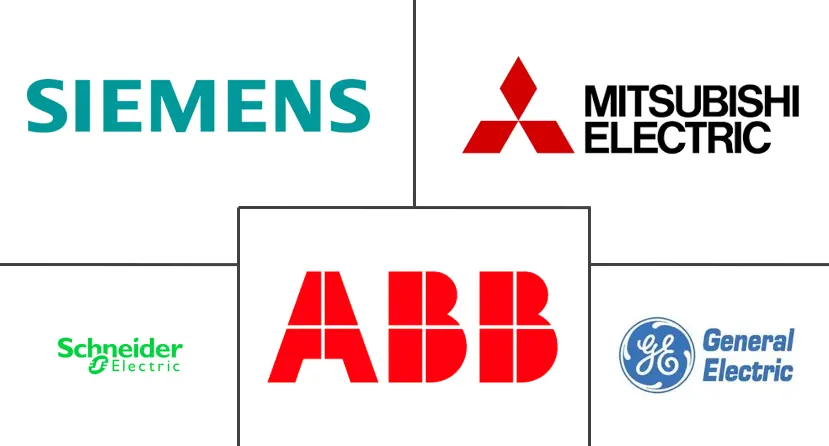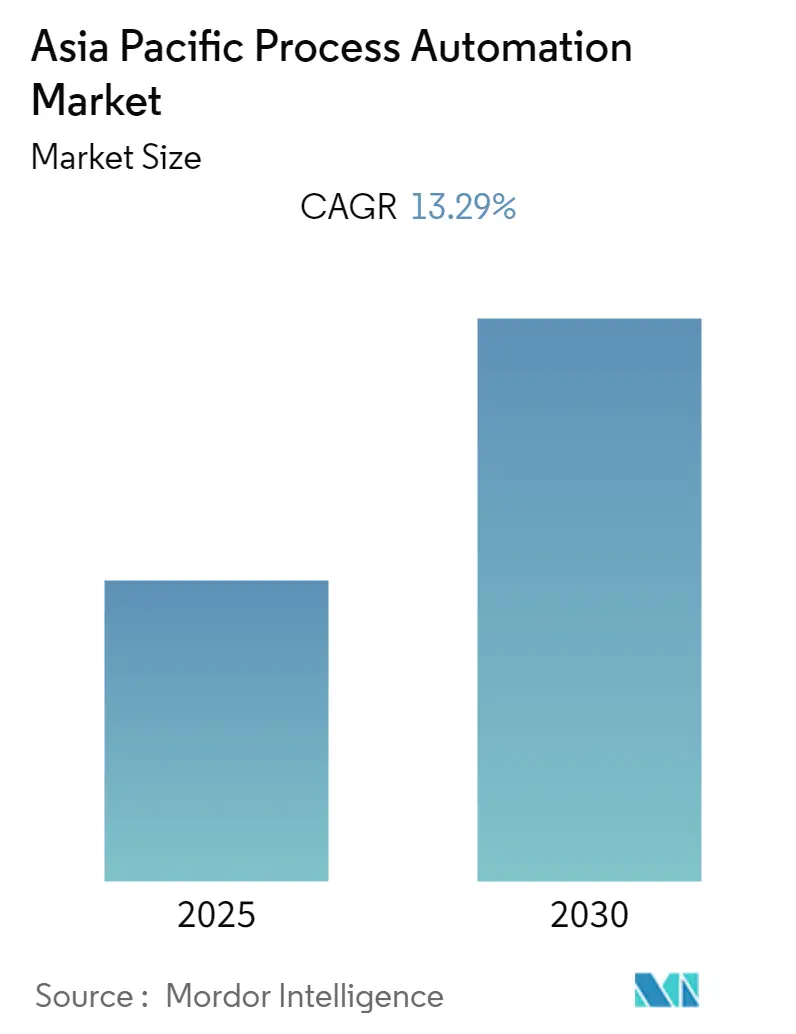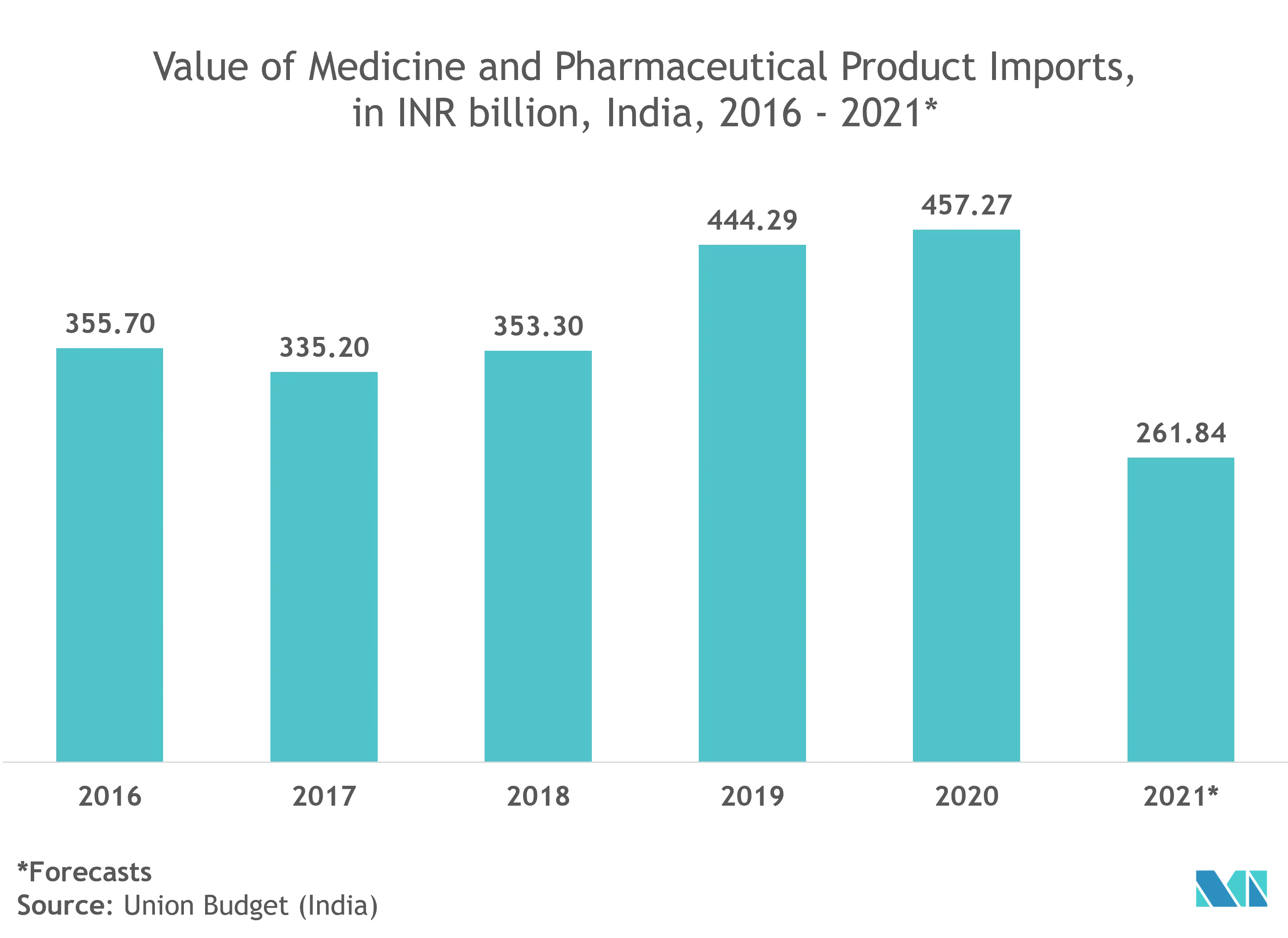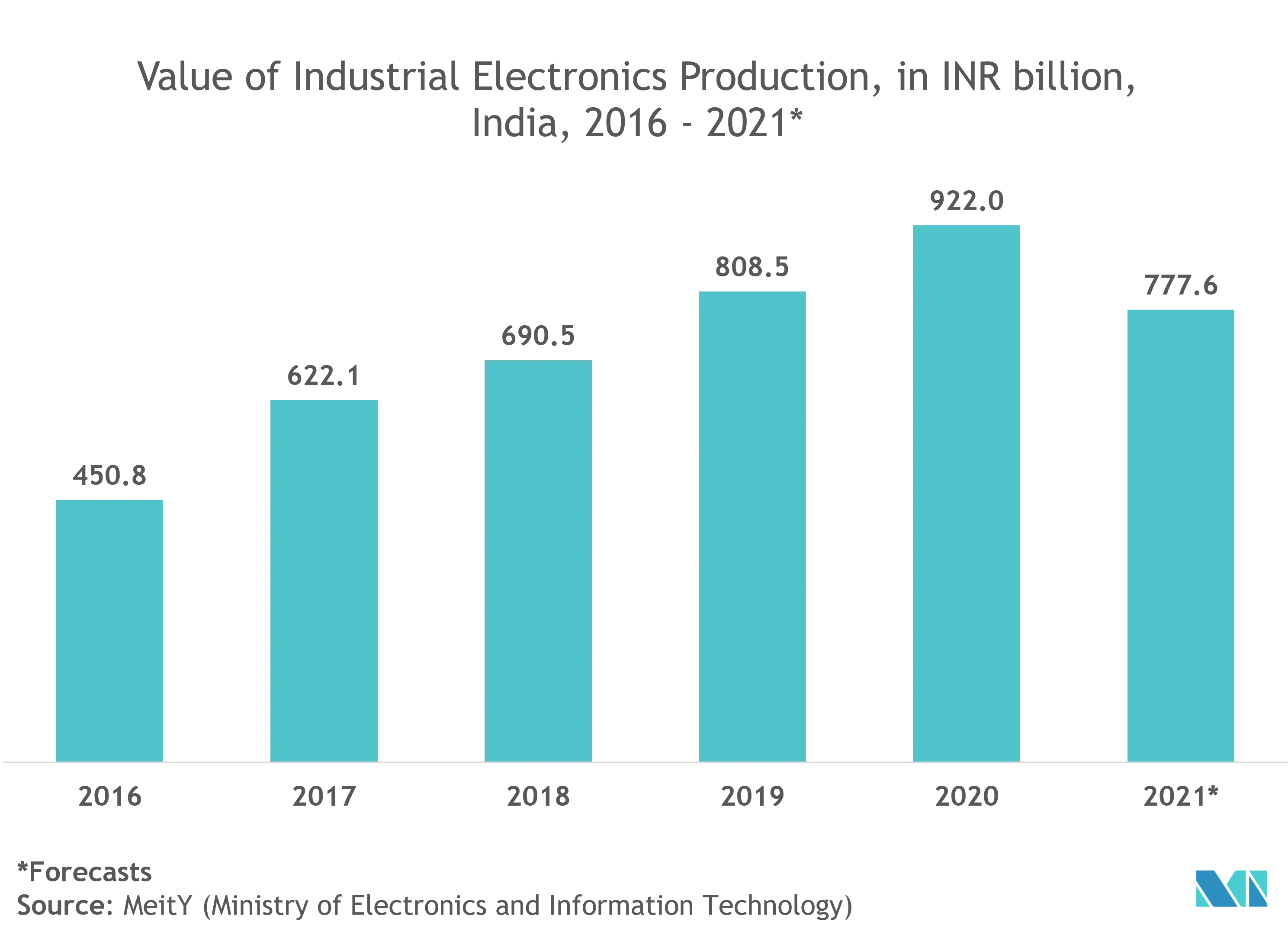APAC Process Automation Market Analysis
The Asia Pacific Process Automation Market is expected to register a CAGR of 13.29% during the forecast period.
- The automation industry has been revolutionized by combining the digital and physical aspects of manufacturing, aiming to deliver optimum performance. Further, the focus on achieving zero waste production and shorter time to market has augmented the market's growth.
- Automation of manufacturing processes has offered various benefits, such as effortless monitoring, reduction of waste, and production speed. This technology offers customers an improved quality with standardization and dependable products within time and at a much lower cost.
- Connecting the industrial machinery and equipment and obtaining real-time data have played a vital role in the adoption of SCADA, HMI, PLC systems, and software that offer visualization; thus enables reducing the faults in the product, reducing downtime, scheduling maintenance, and switching from being in the reactive state to predictive and prescriptive stages for decision-making.
- Moreover, the virtualization of automation control systems is a key trend observed in the market, also known as the thin layer between the virtual machine and host server. The virtual machine contains the operating system and software. Different operating systems are operated on top of a primary operating system using virtual machines. Virtualization can be applied on layers in an industrial premise, such as server, storage, desktop, file, and network. It provides benefits, such as optimum resource utilization and operation, as well as power cost savings.
- Vendor activity, such as product innovations, strategic mergers, and acquisitions, etc., taking place in the space is expected to drive the demand. New products are considered as the primary activity. In May 2020, OleumTech, wireless industrial automation, and IoT solution provider announced the launch of new smart pressure transmitters (HGPT smart gauge pressure transmitters).
- Further, different industrial automation systems, such as SCADA, PLCs, and MES on a single physical server, can be easily accessed at a different location on the plant floor using virtual machines. It has been adopted to reduce the overall cost for servers and increase the flexibility in adopting industrial automation systems and software in the process and discrete industries.
APAC Process Automation Market Trends
Pharmaceutical Industry is Expected to Hold Significant Market Share
- The pharmaceutical industry is highly regulated due to the importance placed on public health safety. Accuracy, repeatability, and control are the key benefits of an automated system, helping to enhance productivity, safety, and cleanliness in pharmaceutical manufacturing facilities. The need for process optimization, regulatory compliance, and enhancements in the supply chain are driving investment in automation technologies across the pharmaceutical industry.
- Moreover, an increase in the need for process automation solutions to various processes such as manufacturing, testing, drug development, packaging, and distribution are among the factors that are likely to propel the growth in the pharmaceutical industry in the process automation and instrumentation market.
- Additionally, many pharmaceutical companies have entered the market for process automation due to complex manufacturing processes such as milling, granulation, coating, and tablet pressing.
- Systems and processes in pharmaceutical units utilize concepts of batch automation and recipe management. If there is any slight change in the recipe or even a single ingredient is missing/added, the formula and composition of the drug change. This can seriously affect the health and lives of consumers. Process optimization and automation ensure that consistency is maintained in each batch.
- Further, automation offers better control of processes and the ability to monitor processes from remote locations. It assists in automatically creating reports, entering essential data, and sharing real-time information. Automation is transforming pharma concerning product development, commercial production, and real-time monitoring. It can foster manufacturing excellence by adopting sensors and systems to help companies achieve compliance at the lowest costs.
India is Expected to Account For Significant Market Share
- Fuelled by Industry 4.0, India continues to innovate and consolidate its position in the global market in the factory automation and industrial control systems industry. The embracing of smart technologies in the studied market has also positively impacted the national economy.
- Increased global manufacturing integration is raising the pressure for automation investment, as cost minimization with quality maximization looms ever more significantly as an operating paradigm for Indian manufacturers.
- With cyber-attacks increasing in smart factories in India, there is growing concern about using Industrial Control Systems. The government has plans to curb the rise of such crimes. This aligns with the growing trend of the usage of industrial control systems manufactured in the country for smart factories to avoid the risk of cybersecurity breaches. A company like Honeywell completes smart manufacturing solutions, including ERP and numerous others.
- Moreover, with investment roll-outs by the government to revive the pandemic hit India economy, infrastructure, and the electronics industry are marked as the primary beneficiaries alongside the growth of small and medium-sized enterprises. The infrastructure and electronics industry are heavy users of the industrial control systems' hardware products and software solutions and are expected to have a direct positive effect.
- Further, technologies and terminologies such as process discovery, process optimization, process intelligence, and process orchestration are becoming a more significant part of Robotic Process Automation (RPA). There is an ongoing trend of increasing a closer relationship between business process management (BPM) and RPA in the future.
APAC Process Automation Industry Overview
The Asia Pacific Process Automation Market is moderately fragmented, with few new entrants and few dominant players. The companies keep on innovating and entering into strategic partnerships to retain their market share. Some of the recent developments in the market are:
- July 2021 - Emerson Electric Corporation announced the launch of its Planet Web Optics Data Lake, an enterprise-level data management software solution that helps manufacturers reduce data complexity to fully leverage operations data across a production site or from multiple locations to improve profitability enterprise-wide.
- May 2020 - RoviSys announced its collaboration with VANTIQ, a developer of high-end applications to develop applications that can detect and contain COVID-19 in the food and beverage industry, apart from the critical life science sector.
APAC Process Automation Market Leaders
-
ABB Ltd
-
Siemens AG
-
Schneider Electric SE
-
General Electric Co.
-
Mitsubishi Electric
- *Disclaimer: Major Players sorted in no particular order
APAC Process Automation Market News
- July 2021 - Rockwell Automation, Inc announced a partnership with Kezzler AS, cloud-based product digitization and traceability platform, to help manufacturers capture the journey of their products from raw material sources to point-of-sale or beyond using cloud-based supply chain solutions that focus on product traceability.
- March 2021 - Mitsubishi announced establishing the Industrial Mechatronics Systems Works within the company's Nagoya Works in Nagoya, Japan. The Industrial Mechatronics Systems Works will become Mitsubishi Electric's dedicated factory for industrial mechatronic products, which contribute to the manufacturing industry by automating product and parts processing.
APAC Process Automation Industry Segmentation
The study characterizes the process automation market based on the system type, end-user industry, and country. The study describes the process automation market based on the technology type, a communication protocol that includes wired and wireless protocol, System type, end-user industry, and country. Further, the study comprises Software & Services and the impact of COVID-19 on the market.
| By Communication Protocol | Wired | |||
| Wireless | ||||
| By System Type | By System Hardware | Supervisory Control and Data Acquisition System (SCADA) | ||
| Distributed Control System (DCS) | ||||
| Programmable Logic Controller (PLC) | ||||
| Manufacturing Execution System (MES) | ||||
| Valves & Actuators | ||||
| Electric Motors | ||||
| Human Machine Interface (HMI) | ||||
| Process Safety Systems | ||||
| Sensors & Transmitters | ||||
| By Software Type | APC (Standalone & Customized Solutions) | Advanced Regulatory Control | ||
| Multivariable Model | ||||
| Inferential & Sequential | ||||
| Data Analytics & Reporting-based Software | ||||
| Other Software & Services | ||||
| By End-user Industry | Oil and Gas | |||
| Chemical and Petrochemical | ||||
| Power and Utilities | ||||
| Water & Wastewater | ||||
| Food and Beverage | ||||
| Paper & Pulp | ||||
| Pharmaceutical | ||||
| Other End-user Industries | ||||
| By Country | China | |||
| India | ||||
| Japan | ||||
| Rest of Asia Pacific | ||||
APAC Process Automation Market Research FAQs
What is the current Asia Pacific Process Automation Market size?
The Asia Pacific Process Automation Market is projected to register a CAGR of 13.29% during the forecast period (2025-2030)
Who are the key players in Asia Pacific Process Automation Market?
ABB Ltd, Siemens AG, Schneider Electric SE, General Electric Co. and Mitsubishi Electric are the major companies operating in the Asia Pacific Process Automation Market.
What years does this Asia Pacific Process Automation Market cover?
The report covers the Asia Pacific Process Automation Market historical market size for years: 2019, 2020, 2021, 2022, 2023 and 2024. The report also forecasts the Asia Pacific Process Automation Market size for years: 2025, 2026, 2027, 2028, 2029 and 2030.
Our Best Selling Reports
Asia Pacific Process Automation Industry Report
Statistics for the 2025 Asia Pacific Process Automation market share, size and revenue growth rate, created by Mordor Intelligence™ Industry Reports. Asia Pacific Process Automation analysis includes a market forecast outlook for 2025 to 2030 and historical overview. Get a sample of this industry analysis as a free report PDF download.







